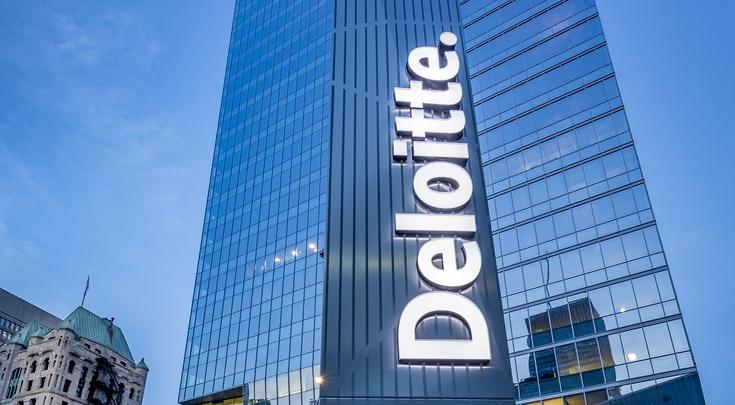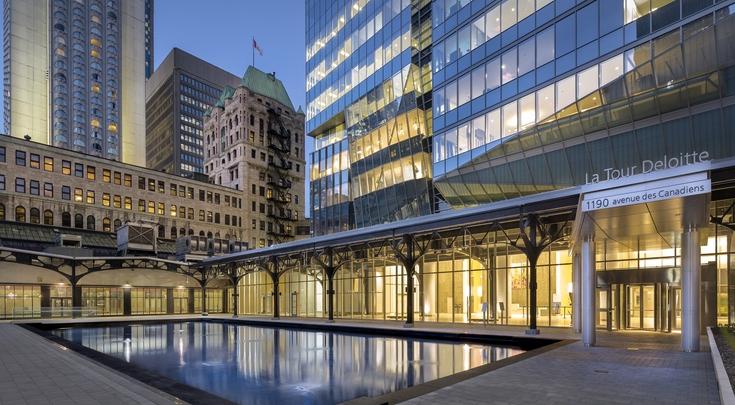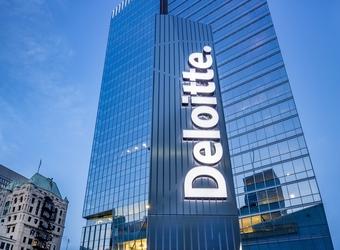Deloitte Tower uses Technoform for energy efficient glazing

The Deloitte Tower uses energy efficient glazing in the quest for LEED Platinum certification
Luc Cormier, vice president of operations at Multiver
The challenge - aggressive green building performance
The Cadillac Fairview Corporation Limited, along with its major tenant Deloitte, has helped create the first, new, privately-owned and financed commercial office tower in more than 20 years to be built in the city of Montreal, Quebec. This marks the first step in a $2 billion multiyear plan to develop a prime sector of downtown Montreal creating a vibrant new neighborhood known as Quad Windsor.
The tower is located next to the heritage-designated Windsor Station entertainment venue and connects directly to the Bell Centre, home of the Montreal Canadiens professional hockey team. This 560,000 squarefoot project provides premium office space and approximately 230 parking spots in a vibrant and very visible part of downtown Montreal. The spirit of the city is seen as alive and strong in this setting, despite its cold climate.
Cadillac Fairview has initiated a nationwide effort known as Green at Work. This program tracks energy consumption, water usage and waste diversion in developments that the company manages across Canada with the objective of progressive improvement each and every year. For the Deloitte Tower, the decision was made to target a LEED® Platinum CS certification for the Core and Shell of the building. Tenants, including Deloitte, are subsequently requested to pursue LEED® CI for Commercial Interiors at the gold or platinum level. This progressive approach puts the development and its tenants at the forefront of sustainable office design in Canada. The challenge includes allowing plenty of natural daylight to reduce electric light usage while still efficiently keeping heat gain and loss under control. The intent is to realize energy cost savings of 35-40% and reduced greenhouse gas emissions from lower power consumption. The Canadian Green Building Council (CaGBC) oversees the Leadership in Energy and Environmental Design (LEED) program in Canada. Other goals of the certification include sustainable site work, water conservation, indoor environmental quality, and sustainable use of materials and resources.
The design solution - abundant daylight and views
Grey tinted windows are an upcoming trend in architecture, according to the Efficient Windows Collaborative. Grey tinted windows offer a more reflective look from the outside of the building, while providing occupants of the building with a greater sense of transparency in the glass than darker tinted windows. Based on these characteristics, Guardian Industries glass, color AG50 crystal grey, was specified by the architects for the glazing.
Optimizing energy performance with insulating glass
Further, in cold climates like Montreal, condensation can form on the inside of the glass along the cold edges causing other problems for the building components nearby. Together, the architects and Multiver researched and chose glass spacers manufactured by Technoform since they met their design criteria for both excellent energy efficiency and the ability to meet unique aesthetic requirements. Specifically, they selected a 17/32” (13.44mm) TGI®-Spacer in a light grey tone to match the glass color beautifully.
Putting it all together - the curtain wall system
The design team next considered traditional curtain wall systems compared to structural silicone systems. Traditional curtain wall systems use continuously gasketed aluminum pressure plates or caps that can conduct large amounts of heat in or out of the façade resulting in “thermal bridging”. Structurally glazed curtain wall systems consist of glass that is bonded or anchored back to a frame with engineered silicone sealant that can reduce or eliminate the thermal bridging along the joints between adjacent IGUs. The aesthetic benefit of a structural silicone glazed system is the creation of greater transparency than traditional systems. There are less visual interruptions due to the lack of metal on the exterior, creating a seamless, continuous glass look. This system creates a completely clean, flush exterior appearance with superior energy performance. It can also be much more technically complex than a traditional system so the skill and quality control of the Epsylon team was heavily relied upon.
The structural silicone glazed system selected was Epsylon Platinum Series 60.075 – 2S which is the highest performing curtain wall offered by Epsylon Concepts, Ltd. It is a pre-fabricated, unitized system, with structural silicone on 2 sides that allows multiple glazing types and materials to be combined into one ‘unit’ in a quality controlled shop environment. Precision is needed in sealing the units together since there is no outside metal frame to cover any irregularities or imperfections. That goes for the glass spacers used too, since in some cases they can be left partly exposed and create an unintended visual appearance. The TGI®-Spacer used in this project extends the colored polypropylene through an extended sidewall ensuring minimal opportunity for stainless steel peek through and overcoming this common quality control issue on structural silicone glazed units. After the IGUs and spandrel glass are glazed into unit frames within the shop, they are transported and installed at the job site by crane. The installed units then receive additional silicone and or EPDM gaskets on the exterior creating “stack joints” as the complete air and moisture barrier of the system allowing a weep at each floor.
- Technoform's spacer is a unique hybrid spacer system incorporating a high-performance polymer and low conductivity stainless steel to provide minimal heat transfer, while maximizing protection against gas leakage and moisture penetration.
- Technoform spacer’s straight sightline, light grey color and smooth matte finish complemented the desired overall appearance of the glazing and ultimately the whole building.
- To maintain the same aesthetic appearance throughout all glass units, Multiver also used the Technoform's spacer in the spandrel glass panels. Opaque spandrel glass is used in areas that do not require vision glass, such as the horizontal sections along the floor lines where concealing the structure and other building components are required.
- Multiver fabricated the IGUs for the Deloitte Tower in a variety of sizes and shapes to meet the building design, the largest unit being 96" x 140" (2.4384m x 3.556m).

- Deloitte Tower, 1190 Avenue des Canadiens, Montreal, Quebec, Canada
- Owner/Developer: Cadillac Fairview Corporation, Limited
- Architect: Kohn Pedersen Fox (KPF) with Bregman & Hamann (B+H) Architects
- Size: 560,000 square feet (52,100 square meters), 28 stories
- Budget: $200 million


